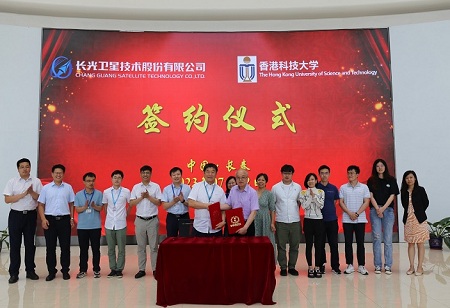-
The Hong Kong University of Science and Technology (HKUST) that it will launch a multispectral optical satellite at the Jiuquan Satellite Launch Center in Gansu with Chang Guang Satellite Technology Company Ltd (Chang Guang) this Friday (August 25). The satellite “HKUST-FYBB#1” will be used for tracking remote sensing data related to global environment, disaster and sustainable development. As the first university in Hong Kong to initiate a satellite mission, the launch also marks HKUST’s first step towards building a remote sensing satellite constellation and a comprehensive environmental monitoring and disaster forecasting system. The multispectral optical satellite set to be launched this Friday for research purposes is the most advanced type in the realm of civilian satellites. The spatial resolution of the remote sensing images it collects is 0.5 meters, which is 20 times higher than the openly accessible data of images taken from the European Space Agency’s Sentinel-2 optical satellite. Its swath of image is over 150 kilometers, comparable to those of the latest generation of the United States’ land satellites. As an expression of gratitude to Mr. Francis YIP Chi-Hung and his wife, Mrs. Catherine YIP NG Bun-Bun, for their generous donation and support for the launch, the satellite is named “HKUST-FYBB#1”. HKUST will use the data collected by the satellite to establish a digital twin system that covers all slopes in the region for the monitoring of their surface conditions, as well as the simulation and showing of the process of landslide disasters and societal responses to emergencies.
This is done in the hope of enhancing coordination and decision-making in disaster response and management. HKUST signed an agreement earlier with Chang Guang, the first commercial remote sensing satellite company in Mainland China. Apart from the launching of “HKUST-FYBB#1”, HKUST and Chang Guang will venture into a long-term, extensive and multi-facet collaboration in satellite research and development for carbon emission and its data application. Combining HKUST’s scientific research capability and achievements in meteorology, oceanography and environmental protection, as well as remote sensing data obtained from Chang Guang’s 108 orbiting satellites, which form the world’s largest sub-meter level commercial remote sensing satellite constellation “JiLin-1”, the parties are set to build a comprehensive environmental monitoring and disaster forecasting system. The system aims to provide scientific data in support of the nation’s dual carbon policy goals, namely peaking carbon emissions by 2030 and achieving carbon neutrality by 2060. It also seeks to enhance the country’s remote sensing technology – a cutting-edge technique involving the collection of electromagnetic radiation information from space or higher altitude on Earth’s surface, as well as the processing and imaging of such data for the identification and understanding of the Earth’s environment and resources. Rendering their full support to the satellite launch, Mr. Francis YIP and Mrs. Catherine YIP said they were delighted to facilitate the strategic cooperation between HKUST and Chang Guang. They stated, “We have seen HKUST’s indefatigable effort and determination in promoting the development of aerospace technology in Hong Kong. We will continue to support HKUST and the innovation and technology development in Hong Kong. This project marks an important milestone in Hong Kong’s aerospace development. As Hongkongers, we feel proud of our city’s progress and are deeply honored to contribute to this project. We would also like to express our gratitude to Prof. LIU Yuyi for inscribing the name of the satellite in calligraphy.”
HKUST Council Chairman Prof. Harry SHUM said, “HKUST is a staunch supporter of sustainable development and has always been active in exploring and finding solutions to global carbon emissions problems. In the face of pressing challenge of climate change, we are deeply thankful to Mr. and Mrs. Yip for their support, which allows us to commence on our remote sensing satellite program. We look forward to cooperation with the government, research institutes, enterprises and different sectors for wider application of the data we will obtain through our cooperation with Chang Guang. Together, we can make contributions to the nation’s dual carbon policy goals, our government’s carbon emissions targets, and the easing of global climate change to demonstrate our commitment in sustainable development". HKUST President Prof. Nancy IP also expressed her gratitude to Mr. and Mrs. Yip. She said, “HKUST strongly encourages our researchers to engage in exploratory, socially impactful frontier research projects, and to actively work with industry partners to actualize scientific discoveries to address global challenges such as natural disasters and climate change. We are excited to partner with Chang Guang to drive aerospace innovation and contribute to the national development strategy. HKUST will fully leverage its research capabilities and continue to promote cooperation among various academic, research, and industry sectors to strengthen our aerospace industry and achieve the nation’s dual carbon policy goals.
🍪 Do you like Cookies?
We use cookies to ensure you get the best experience on our website. Read more...

